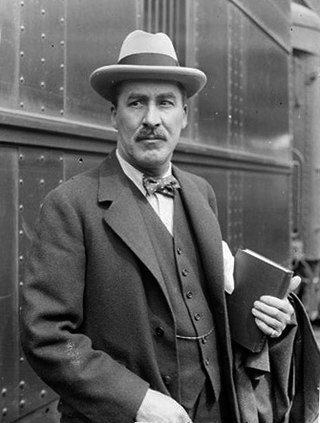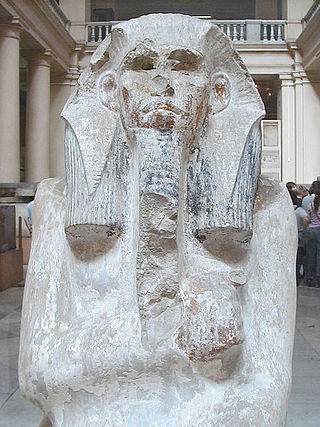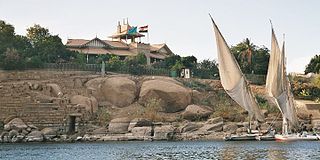Related Research Articles

Howard Carter was a British archaeologist and Egyptologist who discovered the intact tomb of the 18th Dynasty Pharaoh Tutankhamun in November 1922, the best-preserved pharaonic tomb ever found in the Valley of the Kings.

Egyptology is the scientific study of ancient Egypt. The topics studied include ancient Egyptian history, language, literature, religion, architecture and art from the 5th millennium BC until the end of its native religious practices in the 4th century AD.

Bes, together with his feminine counterpart Beset, is an ancient Egyptian deity, likely of Kushite/Nubian or Nehesi C-Group culture origin worshipped as a protector of households and, in particular, of mothers, children, and childbirth. Bes later came to be regarded as the defender of everything good and the enemy of all that is bad. According to Donald Mackenzie in 1907, Bes may have been a Middle Kingdom import from Nubia or Somalia, and his cult did not become widespread until the beginning of the New Kingdom, but more recently several Bes-like figurines have been found in deposits from the Naqada period of pre-dynastic Egypt, like the thirteen figurines found at Tell el-Farkha.

Saqqara, also spelled Sakkara or Saccara in English, is an Egyptian village in the markaz (county) of Badrashin in the Giza Governorate, that contains ancient burial grounds of Egyptian royalty, serving as the necropolis for the ancient Egyptian capital, Memphis. Saqqara contains numerous pyramids, including the Pyramid of Djoser, sometimes referred to as the Step Tomb, and a number of mastaba tombs. Located some 30 km (19 mi) south of modern-day Cairo, Saqqara covers an area of around 7 by 1.5 km.

Djoser was an ancient Egyptian pharaoh of the 3rd Dynasty during the Old Kingdom, and was the founder of that epoch. He is also known by his Hellenized names Tosorthros and Sesorthos. He was the son of King Khasekhemwy and Queen Nimaathap, but whether he was also the direct successor to their throne is unclear. Most Ramesside king lists identify a king named Nebka as preceding him, but there are difficulties in connecting that name with contemporary Horus names, so some Egyptologists question the received throne sequence. Djoser is known for his step pyramid, which is the earliest colossal stone building in ancient Egypt.

Zahi Abass Hawass is an Egyptian archaeologist, Egyptologist, and former Minister of State for Antiquities Affairs, serving twice. He has also worked at archaeological sites in the Nile Delta, the Western Desert and the Upper Nile Valley.
In ancient Egypt, cats were represented in social and religious scenes dating as early as 1980 BC. Several ancient Egyptian deities were depicted and sculptured with cat-like heads such as Mafdet, Bastet and Sekhmet, representing justice, fertility, and power, respectively. The deity Mut was also depicted as a cat and in the company of a cat.
Edeet Ravel is an Israeli-Canadian novelist who lives in Montreal, Quebec, Canada.

The Imhotep Museum is an archaeological museum located at the foot of the Saqqara necropolis complex, near Memphis in Lower Egypt.

The sculpture of the Seated Scribe or Squatting Scribe is a famous work of ancient Egyptian art. It represents a figure of a seated scribe at work. The sculpture was discovered at Saqqara, north of the alley of sphinxes leading to the Serapeum of Saqqara, in 1850, and dated to the period of the Old Kingdom, from either the 5th Dynasty, c. 2450–2325 BCE or the 4th Dynasty, 2620–2500 BCE. It is now in the Louvre-Lens.

The Department of Ancient Egypt is a department forming an historic part of the British Museum, with Its more than 100,000 pieces making it the largest[h] and most comprehensive collection of Egyptian antiquities outside the Egyptian Museum in Cairo.

The Amarna Princess, sometimes referred to as the "Bolton Amarna Princess," is a statue forged by British art forger Shaun Greenhalgh and sold by his father George Sr. to Bolton Museum for £440,000 in 2003. Based on the Amarna art-style of ancient Egypt, the purchase of the Amarna Princess was feted as a "coup" by the museum and it remained on display for three years. However, in November 2005, Greenhalgh was brought under suspicion by Scotland Yard's Arts and Antiquities Unit, and the statue was impounded for further examination in March 2006. It is now displayed as a part of an exhibition of fakes and forgeries.

Aswan Museum is a museum in Elephantine, located on the south-eastern side of Aswan, Egypt. It was set up in 1912 by the British Egyptologist Cecil Mallaby Firth. The museum features artifacts from Nubia, which were housed there during the construction of the Aswan Dam. In 1990, a new department was inaugurated. It displayed findings that were discovered on Elephantine island itself, such as utensils, weapons, pottery and mummies.
Robert George Morkot, FSA is an archaeologist and academic, specialising in Ancient Egypt. He is a Senior Lecturer in Archaeology at the University of Exeter. His current research is focused on the external relations of Ancient Egypt, particularly the relations with Kush (Sudan). He also works on the historiography of Ancient Egypt.

The Sphinx of Taharqo is a granite gneiss statue of a sphinx with the face of Taharqo. He was a Nubian king, who was one of the 25th Egyptian Dynasty rulers of the Kingdom of Kush. It is now in the British Museum in London.
Tasos Neroutsos was a Greek physician and scholar.
The Shigir Sculpture, or Shigir Idol, is the oldest known wooden sculpture. It was carved during the Mesolithic period, shortly after the end of the last Ice Age, and is twice as old as Egypt's Great Pyramid. The wood it was carved from is approximately 12,000 years old.
Michel Baud was a French Egyptologist, head of the Nubian Sudan section in the Department of Egyptian Antiquities of the Louvre Museum. As such, he was the organizer of an exhibition devoted exclusively to Meroe, Sudan's ancient kingdom known for its legendary capital city and its famous royal necropolis. He was also the director of the archaeological mission on the site of the necropolis at Abu Rawash, and published papers on it such as La ceramique miniature d'Abou Rawash. He was a resident of the French Institute of Oriental Archaeology in Cairo. He was also the author of works on the late Old Kingdom South Saqqara Stone annal document with Vassil Dobrev, published between 1995 and 1997 in BIFAO.

The Ministry of Tourism and Antiquities is the Egyptian government organization which serves to protect and preserve the heritage and ancient history of Egypt. In December 2019 it was merged into the Ministry of Tourism with Khaled al-Anani retaining his function. He was replaced by Ahmed Issa as Minister of Tourism and Antiquities in a cabinet reshuffle on 13 August 2022.

The Twenty-sixth Dynasty of Egypt was the last native dynasty of ancient Egypt before the Persian conquest in 525 BC. The dynasty's reign is also called the Saite Period after the city of Sais, where its pharaohs had their capital, and marks the beginning of the Late Period of ancient Egypt.
References
- ↑ Concordia University (March 14, 2007). "The Starving of Saqqara sculpture". flickr. Retrieved 4 October 2012.
- ↑ Concordia University. "CSI Montreal: Concordia Sculpture Investigation". Diniacopoulos Antiquities Collection. Retrieved 2021-09-03.
- ↑ "Sculpture mystery baffles Concordia researchers". CBC.ca . Mar 17, 2011. Retrieved 18 March 2011.
- ↑ Curran, Peggy (March 17, 2011). "Experts can't crack Concordia sculpture riddle". The Gazette . Retrieved 18 March 2011– via sculptsite.com.
- ↑ Boswell, Randy (16 Mar 2011). "Canadian university puts ancient, mysterious sculpture on display". The Vancouver Sun. Postmedia Network Inc. Archived from the original on 2011-03-16. Retrieved 14 May 2022.
- 1 2 3 "Egyptian Enigma: The Starving of Saqqara". World Archaeology . May 7, 2011. Retrieved March 2, 2023.
- ↑ "The mystery of 'The Starving of Saqqara'". Past Horizons. March 16, 2011. Archived from the original on 21 March 2011. Retrieved 25 March 2011.